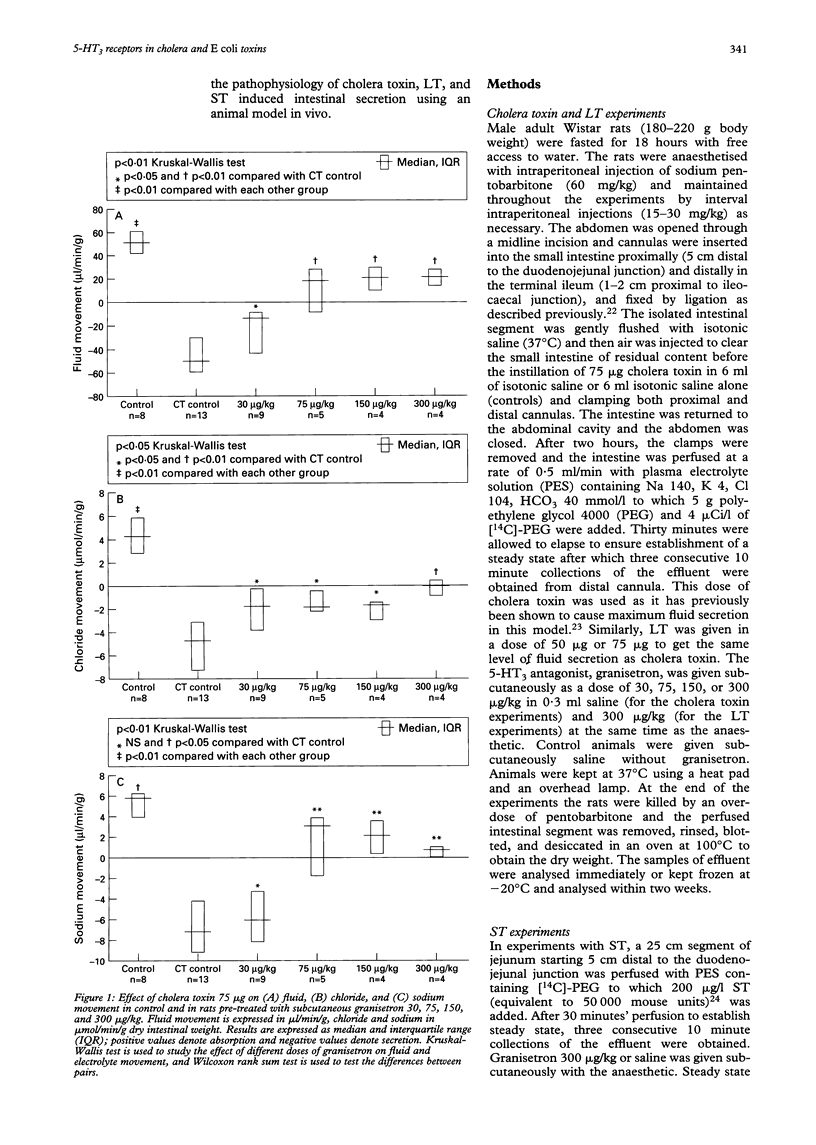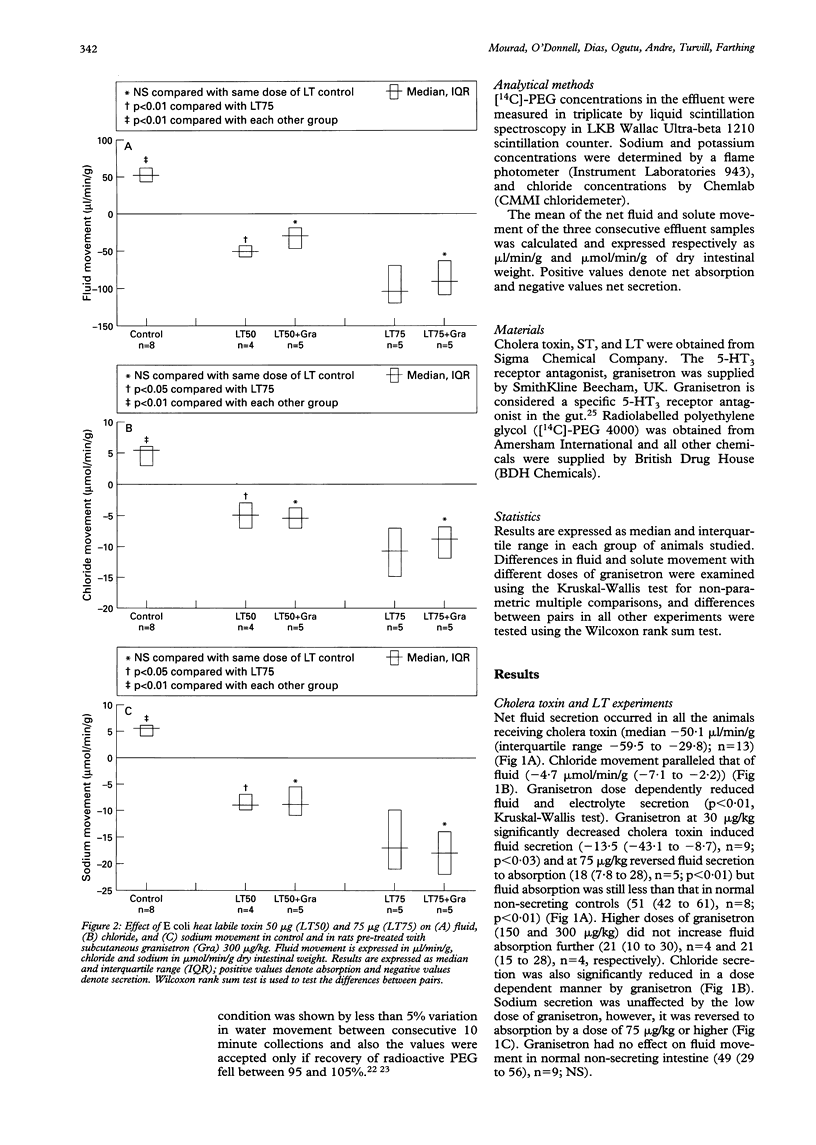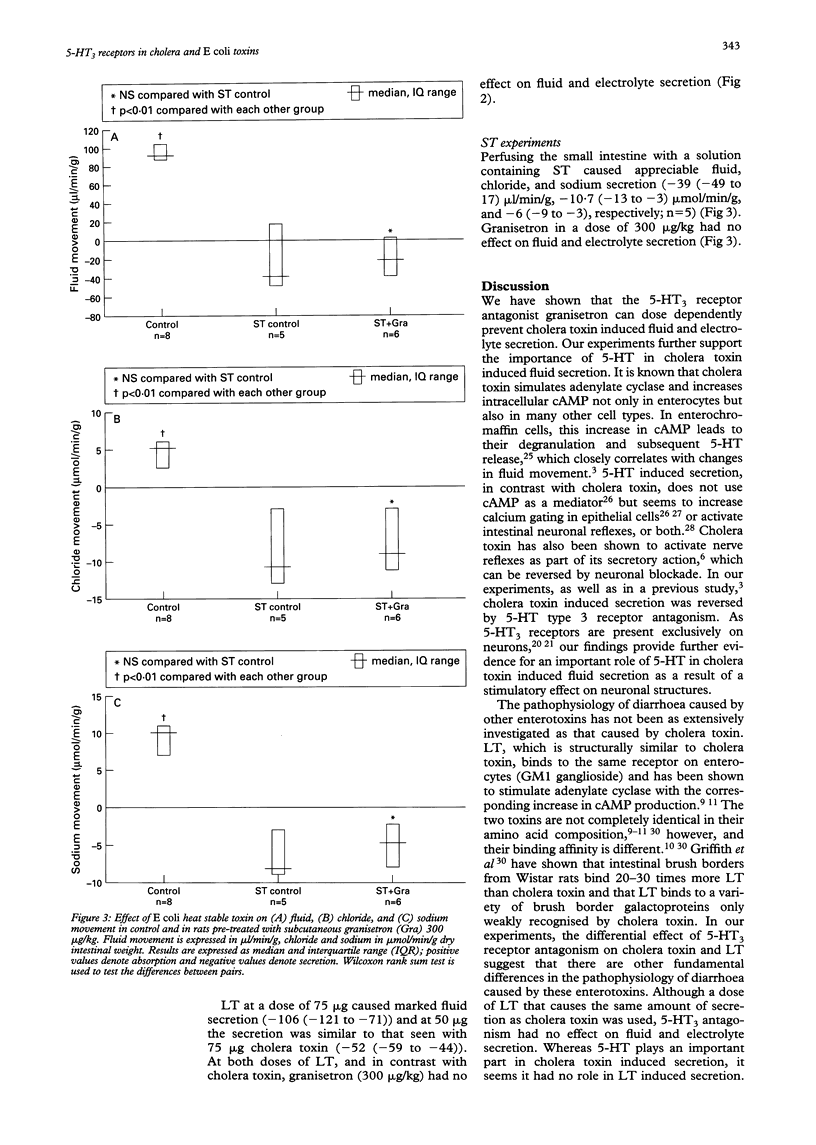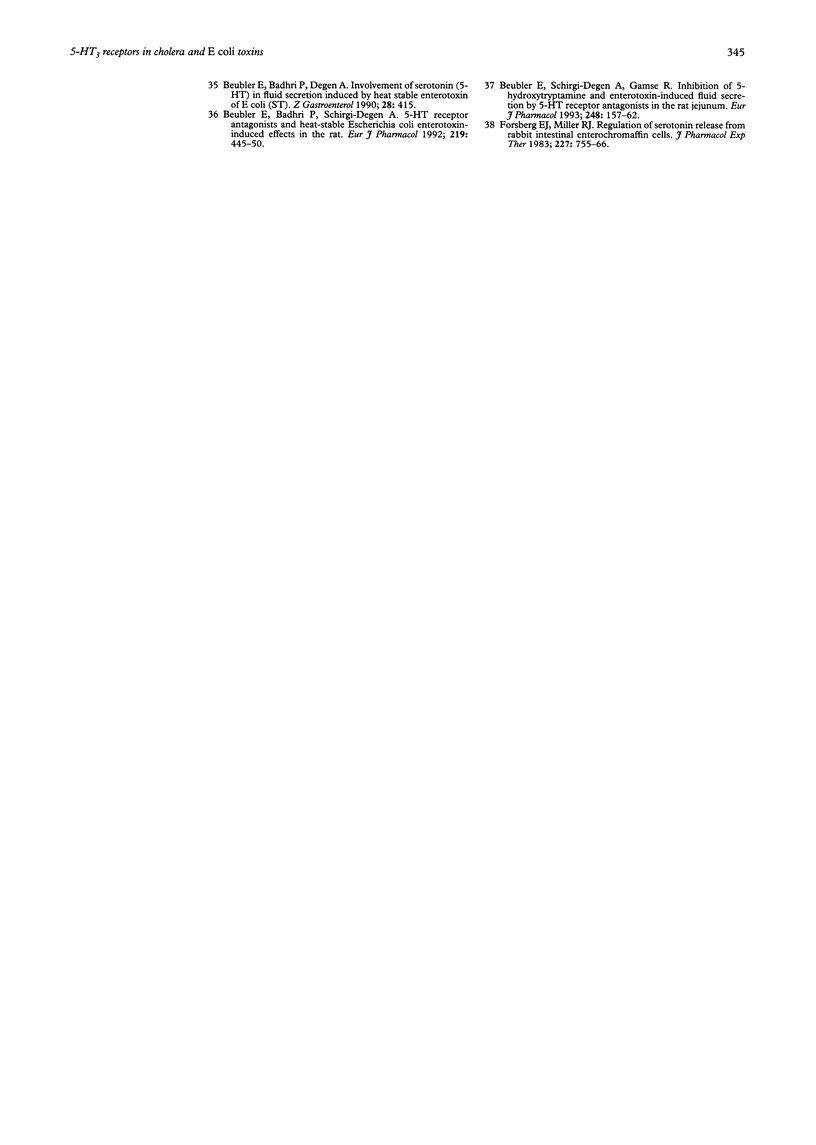Abstract
Cholera toxin and Escherichia coli heat labile toxin (LT) induced intestinal secretion has in the past been attributed exclusively to an increase in intracellular cAMP whereas E coli heat stable toxin (ST) induced secretion is mediated through cGMP. Evidence is accumulating on the importance of 5-hydroxytryptamine (5-HT) in cholera toxin induced secretion, but its role in LT and ST is not well established. This study therefore investigated in vivo the effect of 5-HT3 receptor antagonist, granisetron, on intestinal fluid and electrolyte secretion induced by cholera toxin, LT, and ST. Granisetron (30, 75, 150, or 300 micrograms/kg) was given subcutaneously to adult male Wistar rats 90 minutes before instillation of 75 micrograms cholera toxin or 50 micrograms LT in isolated whole small intestine. In situ small intestinal perfusion was performed with an iso-osmotic plasma electrolyte solution (PES) to assess fluid movement. In a second group of animals, granisetron (300 micrograms/kg) was given subcutaneously and two hours later small intestinal perfusion with PES containing 200 micrograms/l ST was performed. Cholera toxin induced net fluid secretion (median -50.1 microliters/min/g (interquartile range -59.5 to -29.8)) was found to be dose dependently decreased or abolished by granisetron (plateau effect at 75 micrograms/kg: 18 (-7.8 to 28), p < 0.01). Granisetron in high dose (300 micrograms/kg), however, failed to prevent LT or ST induced secretion (-52 (-121 to -71) v -31 (-44 to -18), and (-39 (-49 to 17) v (-22 (-39 to -3)), respectively). Sodium and chloride movement paralleled that of fluid. In conclusion, these data show that 5-HT and 5-HT3 receptors play an important part in cholera toxin induced secretion but are not involved in E coli heat stable or heat labile toxin induced secretion.
Full text
PDF





Selected References
These references are in PubMed. This may not be the complete list of references from this article.
- Ahrens F. A., Zhu B. Effects of indomethacin, acetazolamide, ethacrynate sodium, and atropine on intestinal secretion mediated by Escherichia coli heat-stable enterotoxin in pig jejunum. Can J Physiol Pharmacol. 1982 Oct;60(10):1281–1286. doi: 10.1139/y82-188. [DOI] [PubMed] [Google Scholar]
- Beubler E., Badhri P., Schirgi-Degen A. 5-HT receptor antagonists and heat-stable Escherichia coli enterotoxin-induced effects in the rat. Eur J Pharmacol. 1992 Sep 4;219(3):445–450. doi: 10.1016/0014-2999(92)90486-n. [DOI] [PubMed] [Google Scholar]
- Beubler E., Bukhave K., Rask-Madsen J. Significance of calcium for the prostaglandin E2-mediated secretory response to 5-hydroxytryptamine in the small intestine of the rat in vivo. Gastroenterology. 1986 Jun;90(6):1972–1977. doi: 10.1016/0016-5085(86)90269-6. [DOI] [PubMed] [Google Scholar]
- Beubler E., Horina G. 5-HT2 and 5-HT3 receptor subtypes mediate cholera toxin-induced intestinal fluid secretion in the rat. Gastroenterology. 1990 Jul;99(1):83–89. doi: 10.1016/0016-5085(90)91233-v. [DOI] [PubMed] [Google Scholar]
- Beubler E., Kollar G., Saria A., Bukhave K., Rask-Madsen J. Involvement of 5-hydroxytryptamine, prostaglandin E2, and cyclic adenosine monophosphate in cholera toxin-induced fluid secretion in the small intestine of the rat in vivo. Gastroenterology. 1989 Feb;96(2 Pt 1):368–376. doi: 10.1016/0016-5085(89)91560-6. [DOI] [PubMed] [Google Scholar]
- Beubler E., Schirgi-Degen A., Gamse R. Inhibition of 5-hydroxytryptamine- and enterotoxin-induced fluid secretion by 5-HT receptor antagonists in the rat jejunum. Eur J Pharmacol. 1993 Aug 2;248(2):157–162. doi: 10.1016/0926-6917(93)90038-r. [DOI] [PubMed] [Google Scholar]
- Cassuto J., Jodal M., Tuttle R., Lundgren O. On the role of intramural nerves in the pathogenesis of cholera toxin-induced intestinal secretion. Scand J Gastroenterol. 1981 Apr;16(3):377–384. doi: 10.3109/00365528109181984. [DOI] [PubMed] [Google Scholar]
- Clements J. D., Finkelstein R. A. Isolation and characterization of homogeneous heat-labile enterotoxins with high specific activity from Escherichia coli cultures. Infect Immun. 1979 Jun;24(3):760–769. doi: 10.1128/iai.24.3.760-769.1979. [DOI] [PMC free article] [PubMed] [Google Scholar]
- Eklund S., Jodal M., Lundgren O. The enteric nervous system participates in the secretory response to the heat stable enterotoxins of Escherichia coli in rats and cats. Neuroscience. 1985 Feb;14(2):673–681. doi: 10.1016/0306-4522(85)90318-5. [DOI] [PubMed] [Google Scholar]
- Eklund S., Karlström L., Rökaeus A., Theodorsson E., Jodal M., Lundgren O. Effects of cholera toxin, Escherichia coli heat stable toxin and sodium deoxycholate on neurotensin release from the ileum in vivo. Regul Pept. 1989 Dec;26(3):241–252. doi: 10.1016/0167-0115(89)90192-4. [DOI] [PubMed] [Google Scholar]
- Elliott E. J., Watson A. J., Walker-Smith J. A., Farthing M. J. Search for the ideal oral rehydration solution: studies in a model of secretory diarrhoea. Gut. 1991 Nov;32(11):1314–1320. doi: 10.1136/gut.32.11.1314. [DOI] [PMC free article] [PubMed] [Google Scholar]
- Field M., Graf L. H., Jr, Laird W. J., Smith P. L. Heat-stable enterotoxin of Escherichia coli: in vitro effects on guanylate cyclase activity, cyclic GMP concentration, and ion transport in small intestine. Proc Natl Acad Sci U S A. 1978 Jun;75(6):2800–2804. doi: 10.1073/pnas.75.6.2800. [DOI] [PMC free article] [PubMed] [Google Scholar]
- Field M. Modes of action of enterotoxins from Vibrio cholerae and EScherichia coli. Rev Infect Dis. 1979 Nov-Dec;1(6):918–926. doi: 10.1093/clinids/1.6.918. [DOI] [PubMed] [Google Scholar]
- Forsberg E. J., Miller R. J. Regulation of serotonin release from rabbit intestinal enterochromaffin cells. J Pharmacol Exp Ther. 1983 Dec;227(3):755–766. [PubMed] [Google Scholar]
- Giannella R. A. Suckling mouse model for detection of heat-stable Escherichia coli enterotoxin: characteristics of the model. Infect Immun. 1976 Jul;14(1):95–99. doi: 10.1128/iai.14.1.95-99.1976. [DOI] [PMC free article] [PubMed] [Google Scholar]
- Greenberg R. N., Murad F., Chang B., Robertson D. C., Guerrant R. L. Inhibition of Escherichia coli heat-stable enterotoxin by indomethacin and chlorpromazine. Infect Immun. 1980 Sep;29(3):908–913. doi: 10.1128/iai.29.3.908-913.1980. [DOI] [PMC free article] [PubMed] [Google Scholar]
- Griffiths S. L., Critchley D. R. Characterisation of the binding sites for Escherichia coli heat-labile toxin type I in intestinal brush borders. Biochim Biophys Acta. 1991 Oct 10;1075(2):154–161. doi: 10.1016/0304-4165(91)90246-d. [DOI] [PubMed] [Google Scholar]
- Guarino A., Cohen M., Thompson M., Dharmsathaphorn K., Giannella R. T84 cell receptor binding and guanyl cyclase activation by Escherichia coli heat-stable toxin. Am J Physiol. 1987 Dec;253(6 Pt 1):G775–G780. doi: 10.1152/ajpgi.1987.253.6.G775. [DOI] [PubMed] [Google Scholar]
- Hardcastle J., Hardcastle P. T., Noble J. M. The involvement of calcium in the intestinal response to secretagogues in the rat. J Physiol. 1984 Oct;355:465–478. doi: 10.1113/jphysiol.1984.sp015432. [DOI] [PMC free article] [PubMed] [Google Scholar]
- Hendriks R., Bornstein J. C., Furness J. B. Evidence for two types of 5-hydroxytryptamine receptor on secretomotor neurons of the guinea-pig ileum. Naunyn Schmiedebergs Arch Pharmacol. 1989 Apr;339(4):409–414. doi: 10.1007/BF00736055. [DOI] [PubMed] [Google Scholar]
- Holmgren J., Fredman P., Lindblad M., Svennerholm A. M., Svennerholm L. Rabbit intestinal glycoprotein receptor for Escherichia coli heat-labile enterotoxin lacking affinity for cholera toxin. Infect Immun. 1982 Nov;38(2):424–433. doi: 10.1128/iai.38.2.424-433.1982. [DOI] [PMC free article] [PubMed] [Google Scholar]
- Hughes J. M., Murad F., Chang B., Guerrant R. L. Role of cyclic GMP in the action of heat-stable enterotoxin of Escherichia coli. Nature. 1978 Feb 23;271(5647):755–756. doi: 10.1038/271755a0. [DOI] [PubMed] [Google Scholar]
- Jodal M. Neuronal influence on intestinal transport. J Intern Med Suppl. 1990;732:125–132. doi: 10.1111/j.1365-2796.1990.tb01484.x. [DOI] [PubMed] [Google Scholar]
- Keast J. R., Furness J. B., Costa M. Investigations of nerve populations influencing ion transport that can be stimulated electrically, by serotonin and by a nicotinic agonist. Naunyn Schmiedebergs Arch Pharmacol. 1985 Nov;331(2-3):260–266. doi: 10.1007/BF00634247. [DOI] [PubMed] [Google Scholar]
- Lundgren O., Svanvik J., Jivegård L. Enteric nervous system. I. Physiology and pathophysiology of the intestinal tract. Dig Dis Sci. 1989 Feb;34(2):264–283. doi: 10.1007/BF01536062. [DOI] [PubMed] [Google Scholar]
- Nilsson O., Cassuto J., Larsson P. A., Jodal M., Lidberg P., Ahlman H., Dahlström A., Lundgren O. 5-Hydroxytryptamine and cholera secretion: a histochemical and physiological study in cats. Gut. 1983 Jun;24(6):542–548. doi: 10.1136/gut.24.6.542. [DOI] [PMC free article] [PubMed] [Google Scholar]
- Rolfe V., Levin R. J. Enterotoxin Escherichia coli STa activates a nitric oxide-dependent myenteric plexus secretory reflex in the rat ileum. J Physiol. 1994 Mar 15;475(3):531–537. doi: 10.1113/jphysiol.1994.sp020091. [DOI] [PMC free article] [PubMed] [Google Scholar]
- Rolston D. D., Borodo M. M., Kelly M. J., Dawson A. M., Farthing M. J. Efficacy of oral rehydration solutions in a rat model of secretory diarrhea. J Pediatr Gastroenterol Nutr. 1987 Jul-Aug;6(4):624–630. doi: 10.1097/00005176-198707000-00023. [DOI] [PubMed] [Google Scholar]
- Sack R. B. Enterotoxigenic Escherichia coli: identification and characterization. J Infect Dis. 1980 Aug;142(2):279–286. doi: 10.1093/infdis/142.2.279. [DOI] [PubMed] [Google Scholar]
- Spangler B. D. Structure and function of cholera toxin and the related Escherichia coli heat-labile enterotoxin. Microbiol Rev. 1992 Dec;56(4):622–647. doi: 10.1128/mr.56.4.622-647.1992. [DOI] [PMC free article] [PubMed] [Google Scholar]


